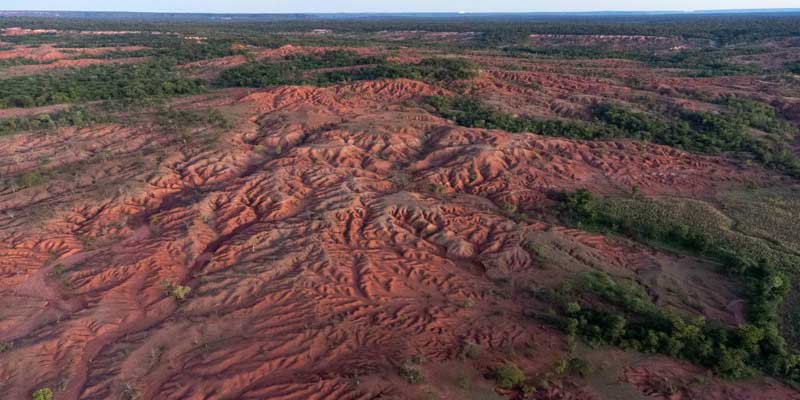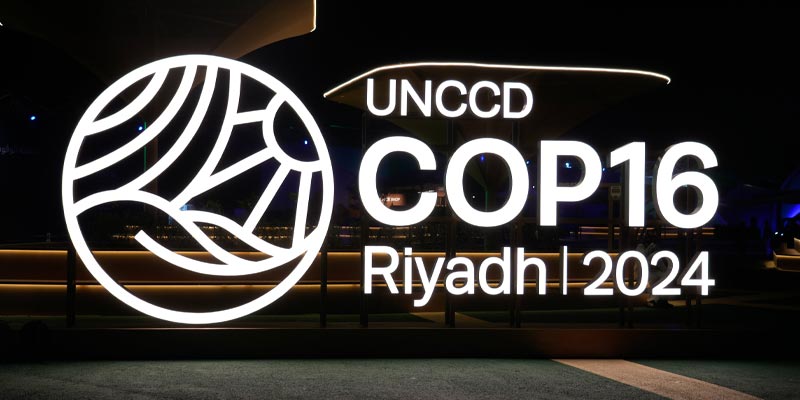- World
- Dec 02
Explainer - Land degradation and desertification
• On December 2, countries from around the world will meet in Riyadh under the auspices of the UN Convention to Combat Desertification (UNCCD) to discuss how to turn the corner from degradation to regeneration.
• The 16th Session of the Conference of the Parties (COP16) of the UNCCD will take place from December 2 to 13 in Riyadh, Saudi Arabia.
• UNCCD COP16 represents a moonshot moment to raise global ambition and accelerate action on land and drought resilience through a people-centered approach.
• As the first UNCCD COP to be held in the Middle East and North Africa region, this landmark event will be the largest and most ambitious summit on land and drought resilience, coinciding with the 30th anniversary of UNCCD, one of three Rio Conventions alongside climate and biodiversity.
What is land degradation?
Land degradation is caused by multiple forces, including extreme weather conditions, particularly drought. It is also caused by human activities that pollute or degrade the quality of soils and land utility. It negatively affects food production, livelihoods, and the production and provision of other ecosystem goods and services.
What is desertification?
Desertification is not the natural expansion of existing deserts but the degradation of land in arid, semi-arid, and dry sub-humid areas. It is a gradual process of soil productivity loss and the thinning out of the vegetative cover because of human activities and climatic variations such as prolonged droughts and floods. What is alarming is that though the land’s topsoil, if mistreated, can be blown and washed away in a few seasons, it takes centuries to build up. Among human causal factors are overcultivation, overgrazing, deforestation, and poor irrigation practices. Such overexploitation is generally caused by economic and social pressure, ignorance, war, and drought.
No life without land
• It is perhaps to state the obvious, but without healthy land there can be no life. It feeds and shelters humanity.
• It provides jobs, sustains livelihoods and is the bedrock of local, national and global economies. It helps to regulate climate and is essential for biodiversity.
• Despite its importance to life as we know it, up to 40 per cent of the world’s land is degraded, affecting around 3.2 billion people, that is almost half of the global population.
• From deforested mountains in Haiti, to the gradual disappearance of Lake Chad in the Sahel and the drying up of productive lands in Georgia in eastern Europe, land degradation affects all parts of the world.
• About 100 million hectares (or one million square kilometres), that is the size of a country like Egypt, of healthy and productive land is lost each year.
• The soils on these lands which can take hundreds of years to form are being depleted, often by extreme weather.
• Droughts are hitting harder and more often, three out of four people in the world are projected to face water scarcity by 2050.
• Temperatures are increasing due to climate change further driving extreme weather events, including droughts and floods, adding to the challenge of keeping land productive.
• There is clear evidence that land degradation is interconnected with broader environmental challenges like climate change.
• Land ecosystems absorb one-third of human CO2 emissions, the gas that is driving climate change. However, poor land management threatens this critical capacity, further compromising efforts to slow down the release of these harmful gasses.
• Deforestation, which contributes to desertification, is on the rise, with only 60 per cent of the world's forests still intact, falling below what the UN calls the ‘safe target of 75 per cent’.
India achieves around 80% land restoration target
• India has already restored 18.94 million hectares of degraded land against the 2030 target of 24 million hectares, Union Minister of State for Environment Kirti Vardhan Singh informed the Rajya Sabha.
• India has committed to restoring 26 million hectares of degraded land by 2030 as part of its obligations under the Bonn Challenge and the UNCCD.
• The country has also committed to creating an additional carbon sink of 2.5 to 3 billion tonnes of carbon dioxide equivalent by 2030 through enhanced forest and tree cover, as part of its Nationally Determined Contributions (or national climate plans) under the Paris Agreement.
• At the 16th UN Biodiversity Conference in Cali, Colombia, in October, India launched its updated biodiversity action plan with a goal to protect at least 30 per cent of its terrestrial, inland water, and coastal and marine areas by 2030, in line with global biodiversity targets.
The United Nations Convention to Combat Desertification
• The United Nations Convention to Combat Desertification (UNCCD) is the sole legally binding international agreement linking environment and development to sustainable land management. The Convention addresses specifically the arid, semi-arid and dry sub-humid areas, known as the drylands, where some of the most vulnerable ecosystems and peoples can be found.
• The Convention was adopted in Paris on June 17, 1994 and entered into force on December 26, 1996 after the 50th ratification was received.
• It is the only legally binding framework set up to address desertification and the effects of drought.
• There are 197 Parties to the Convention, including 196 country Parties and the European Union.
• The Convention’s 197 Parties work together to improve the living conditions for people in drylands, to maintain and restore land and soil productivity, and to mitigate the effects of drought.
• Parties to the Convention meet in Conferences of the Parties (COP) every two years, as well as in technical meetings throughout the year, to advance the aims and ambitions of the Convention and achieve progress in its implementation.
• It unites governments, scientists, policymakers, private sector and communities around a shared vision and global action to restore and manage the world’s land for the sustainability of humanity and the planet.
• The UNCCD is particularly committed to a bottom-up approach, encouraging the participation of local people in combating desertification and land degradation.
• The UNCCD Secretariat facilitates cooperation between developed and developing countries, particularly around knowledge and technology transfer for sustainable land management.
Manorama Yearbook app is now available on Google Play Store and iOS App Store


